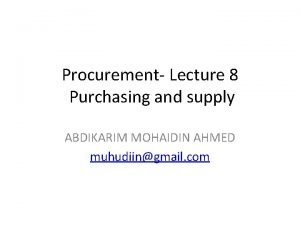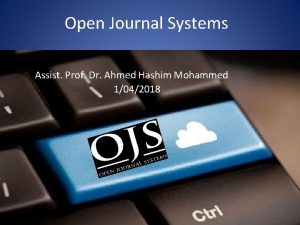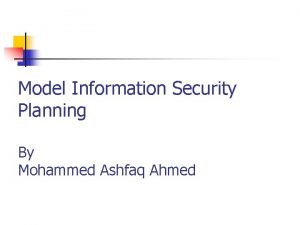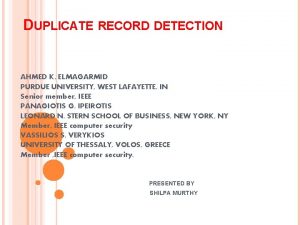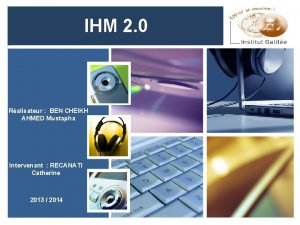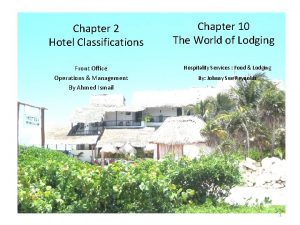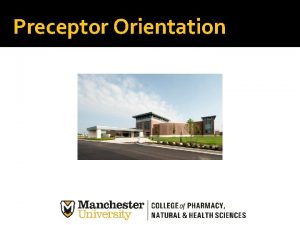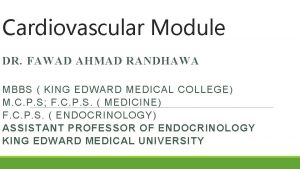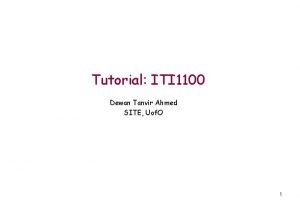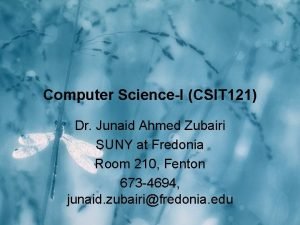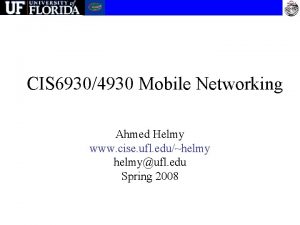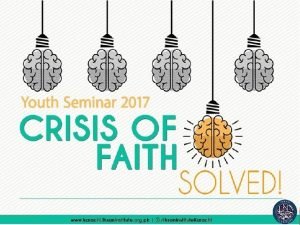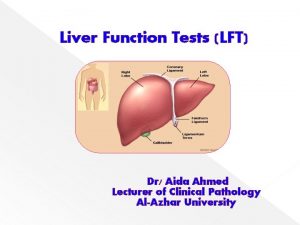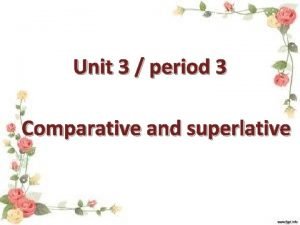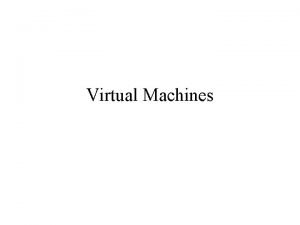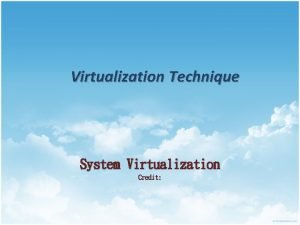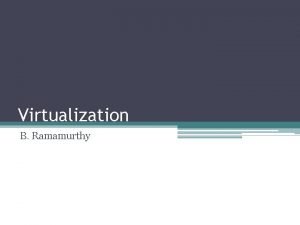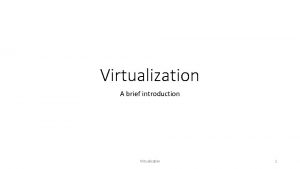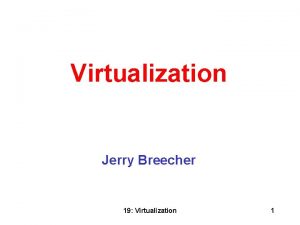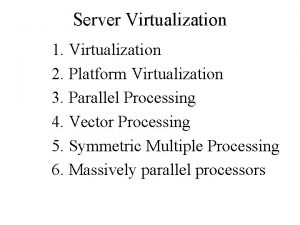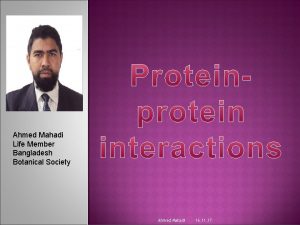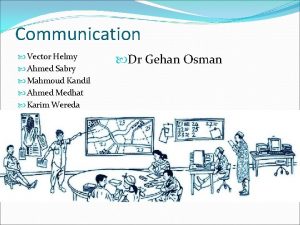Virtualization Dr S R Ahmed Virtualization Virtualization deals




























- Slides: 28

Virtualization Dr. S. R. Ahmed

Virtualization • Virtualization deals with “extending o r replacing an existing interface so as to mimic the behavior of another system” • In computing, virtualization refers to the act of creating a virtual (rather than actual) version of something, including virtual computer hardware platforms, storage devices, and computer network resources.

Virtualization • Virtualization began in the 1960 s, as a method of logically dividing the system resources provided by mainframe computers between different applications. Since then, the meaning of the term has broadened • Virtual system examples: virtual private network, virtual memory, virtual machine

Virtualization • We define virtualization as the art and science of making the function of an object or resource simulated or emulated in software identical to that of the corresponding physically realized object. • In other words, we use an abstraction to make software look and behave like hardware, with corresponding benefits in flexibility, cost, scalability, reliability, and often overall capability and performance, and in a broad range of applications.

Virtualization • Virtualization, then, makes “real” that which is not, applying the flexibility and convenience of software-based capabilities and services as a transparent substitute for the same realized in hardware.

Levels of Virtualization

Relative Merits of Virtualization at Various Levels







• Run legacy software on non-legacy hardware • Run multiple operating systems on the same hardware • Create a manageable upgrade path • Manage outages (expected and unexpected) dynamically

• Reduce costs by consolidating services onto the fewest number of physical machines http: //www. vmware. com/img/serverconsolidation. jpg

Non-virtualized Data Centers • Too many servers for too little work • High costs and infrastructure needs – – – Maintenance Networking Floor space Cooling Power Disaster Recovery

Dynamic Data Center • Virtualization helps us break the “one service per server” model • Consolidate many services into a fewer number of machines when workload is low, reducing costs • Conversely, as demand for a particular service increases, we can shift more virtual machines to run that service • We can build a data center with fewer total resources, since resources are used as needed instead of being dedicated to single services

VM workload multiplexing Separate VM sizing VM multiplexing s 3 s 2 s 1 We expect s 3 < s 1 + s 2. Benefit of multiplexing ! – Multiplex VMs’ workload on same physical server • Aggregate multiple workload. Estimate total capacity need based on aggregated workload • Performance level of each VM be preserved

So, it is just like Java VM, right?


Thee Virtualization Approaches Full Virtualization Paravirtualization Hardware-assisted Virtualization

Full Virtualization – Everything is virtualized – Full hardware emulation – Emulation = latency

Privileged Instructions – Privileged instructions: OS kernel and device driver access to system hardware – Trapped and emulated by VMM

Pros and Cons – Full Virtualization • Pros – Disaster recovery, failover – Virtual appliance deployment – Legacy code on non-legacy hardware • Cons – LATENCY of core four resources – – RAM performance reduced 25% to 75% Disk I/O degraded from 5% to 20% Network performance decreased up to 10% CPU privileged instruction dings nearing 1% to 7%

Paravirtualization –OS or system devices are virtualization aware Requirements: –OS level – recompiled kernel –Device level – paravirtualized or “enlightened” device drivers

Paravirtualization • Pro: fast • Con: requires a specially modified guest OS, thus precludes the ability to run off-the-shelf and legacy OS in paravirtual environments

Hardware-assisted Virtualization – Server hardware is virtualization aware – Hypervisor and VMM load at privilege Ring -1 (firmware) – Removes CPU emulation bottleneck – Memory virtualization coming in quad core AMD and Intel CPUs

Evolution of Software solutions* • 1 st Generation: Full virtualization (Binary rewriting) – Software Based – VMware and Microsoft Virtual Machine • 2 nd Generation: Paravirtualization – Cooperative virtualization – Modified guest – VMware, Xen Virtual … Machine Dynamic Translation VM … • 3 rd Generation: Siliconbased (Hardwareassisted) virtualization – Unmodified guest – VMware and Xen on virtualization-aware hardware platforms VM Virtual Machine Virtual … Machine Operating System Hypervisor Hardware Time *This slide is from Intel® Corporation Virtualization Logic
 Ahmed muhudiin ahmed
Ahmed muhudiin ahmed Ahmed salemi
Ahmed salemi Dr ahmed hashim
Dr ahmed hashim Ahmed bawany academy school & college
Ahmed bawany academy school & college Adeela shafi
Adeela shafi Aida ahmed
Aida ahmed Ahmed mohammed security
Ahmed mohammed security Ahmed chester
Ahmed chester Dr. ahmed akl
Dr. ahmed akl An ahmed duplicate
An ahmed duplicate Chikhaoui ahmed
Chikhaoui ahmed Ahmed mustapha
Ahmed mustapha Hotel sizes classifications
Hotel sizes classifications Dr. ahmed abdelmageed
Dr. ahmed abdelmageed Kulsum ahmed
Kulsum ahmed Adel ahmed alalla
Adel ahmed alalla Dr fawad randhawa
Dr fawad randhawa Dr fayyaz ahmed
Dr fayyaz ahmed Seyyid ahmed han
Seyyid ahmed han Iti 1100
Iti 1100 Dr junaid ahmed
Dr junaid ahmed Ahmed helmy uf
Ahmed helmy uf Ihsan institute
Ihsan institute Botox
Botox Glutamate oxaloacetate transaminase
Glutamate oxaloacetate transaminase Salyanesiz eyalet nedir
Salyanesiz eyalet nedir Modelo de ahmed
Modelo de ahmed Gemini by ahmed essop questions and answers
Gemini by ahmed essop questions and answers Adjective comparative superlative fantastic
Adjective comparative superlative fantastic
